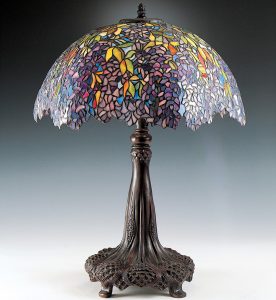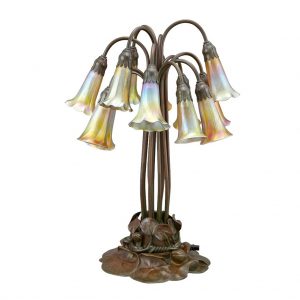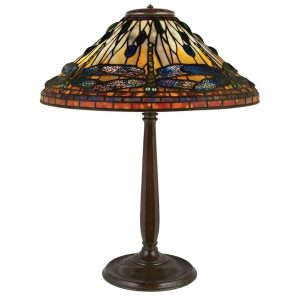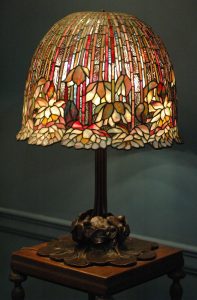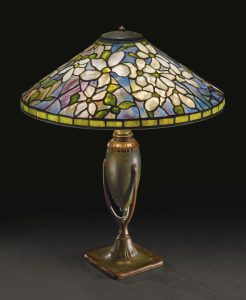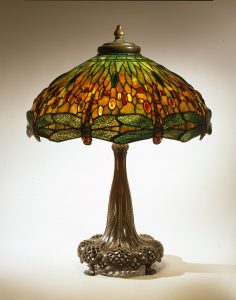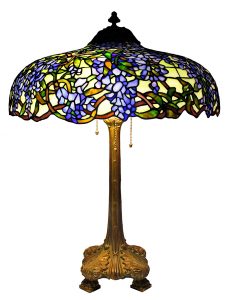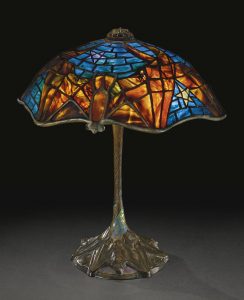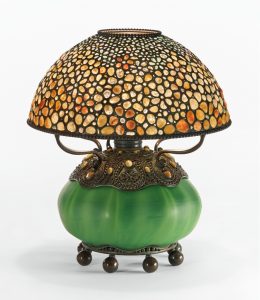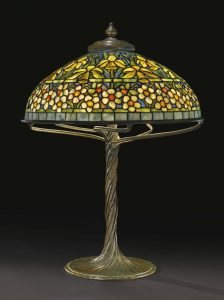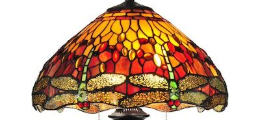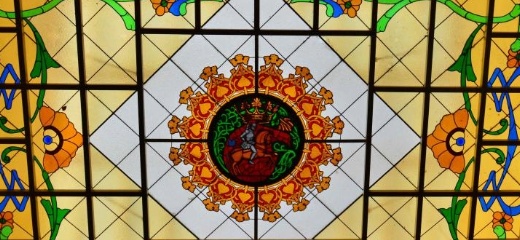Tiffany lamps have become so familiar today that they no longer seem to belong to a particular time and place but they belong to Art Nouveau, a decorative art that owed as much to handicraft as it did to commercial industry. In the United States, these lamps and the firm of Louis Comfort Tiffany played a central role in American Art Nouveau.
They came up with the idea to amalgamate pieces of discarded glass from their high quality stained glass window production to form beautiful decorative lamps, which are recognised for their intricacy of design and superb quality of coloured glass.
After meeting Thomas Edison whilst installing Tiffany lamps in a movie theatre, Tiffany worked closely with him to develop Tiffany lamps with electric fixtures. The formation of Style Art Nouveau coincided with electrification of residential houses – electric lightings came into use. Light sources could be turned at different angles, which made it possible to create lightings of absolutely new original forms.
Louis Comfort Tiffany, one of America’s most applauded artists and a pioneer of the Art Nouveau style, was born in New York in 1848 to Charles Lewis Tiffany, the founder of Tiffany & Co., the highly respected jewellery retailer. Louis Comfort Tiffany founded his own glassmaking firm in 1885, which by 1902 became known as Tiffany Studios. At its peak, the workshop employed more than 300 artists, many of whom were women.
Head of the Women’s Glass Cutting Department Clara Driscoll’s recently discovered correspondence, written during her employment at Tiffany Studios at the turn of the century, reveals that she was responsible for many of the firm’s most iconic lampshades, including the Wisteria, Dragonfly and Poppy, as well as numerous other objects made with glass, bronze and mosaic.
The very first Tiffany lamps were very geometric in design and are usually referred to as Favrile, deriving from the word fabrile meaning ‘handcrafted’. Favrile glass is an iridescent art glass that differs from most other iridescent glasses in that the colour is ingrained into the glass itself. It is under the name ‘Favrile’ which Tiffany patented the design in 1894.
The eclectic colors of the Tiffany stained glasses were carefully hand-fitted into copper foil enclosures, to keep them light weight and sturdy at the same time. The complex designs of his lamps were produced with the help of several skilled craftsmen, and an artist who was later recognized as Clara Driscoll.
Tiffany lamps were originally sold as expensive items but by in the 1920s and 1930s, they were considered fussy and old-fashioned, so some wealthy families would give them to their servants.
Now the original ones can be worth from $5,000 to several hundred thousand dollars or more at the high end. The most ever paid for an original was $2.8 million in 1997 at a Christie’s auction. Antique Tiffany lamps are sought-after today and the market remains competitive for investment-quality works. We have to take into account that there are plenty of fake lamps in the market so expertise is required.
At the bottom of this email you will see our 16 favourite Tiffany Lamps of all times - Our most favourite one is number 12, what about you?
I suggest you to read the interesting article published this week by and written by Casey Lesser "Inside the World’s Largest Collection of Tiffany Glass Lamps".
Founded in the 1880s by painter and interior designer Louis Comfort Tiffany (the son of Charles Lewis Tiffany of jewelry brand Tiffany & Co.), Tiffany Studios is best known for its glasswork—iridescent favrile glass and leaded stained glass, which took the form of windows, mosaics, fire screens, decorative objects, and, of course, the iconic lamps. It is now common knowledge that it was actually a group of self-proclaimed Tiffany Girls who made the lamps under the guidance of Clara Driscoll, head of the women’s glass cutting department from 1892 to 1909.
For decades, outside of dedicated Tiffany collectors, the pieces—poster children, if you will, of Art Nouveau style—have felt more like relics of a bygone era than blue chip collectibles for contemporary homes. But as tastes take a turn toward more decorative interiors and shows like The Gilded Age create renewed intrigue in the era, there’s been an expanded interest around Tiffany. The RealReal listed one recently for $350,000.
Tiffany Lamps are American Art Nouveau icons but Tiffany’s craftsmen (and craftswomen) designed and made extraordinary glass windows, mosaics, vases, and other glass art. Tiffany’s glass also had great success at the 1900 Exposition Universelle in Paris.
Another important figure in American Art Nouveau was the architect Louis Sullivan, best known as the architect of some of the first American iron-framed skyscrapers. At the 1893 World’s Columbian Exposition in Chicago, most famous for the neoclassical architecture of its renowned White City, he designed a spectacular Art Nouveau entrance to the Transportation Building. The Columbian Exposition was also an important venue for Tiffany; a chapel he designed was shown at the Pavilion of Art and Industry. The Tiffany Chapel, along with one of the windows of Tiffany’s home in New York, are now on display at the Charles Hosmer Morse Museum of American Art in Winter Park, Florida.
The multicolored Wisteria shades were remarkable not only for their superb naturalistic integration of vines and blossoms but as a complex technical achievement as well. The traditional straight edge of the opening at the top of the shade was replaced by an openwork crown cast in bronze which simulated the twisted branches of the vine. Wisteria clusters terminated in an irregular lower border of unopened blossoms. Each Wisteria lamp consisted of over a 1,000 pieces of glass. A typical model sold for $400 in 1906.
Inspiration from nature was in full view in the Art Nouveau designs of the late 19th Century. Architect Victor Horta’s exuberant plant tendrils lacing through buildings in Belgium, the lush flowers that are Louis Comfort Tiffany lamps, and the explicitly biomorphic forms of Antonio Gaudí’s buildings all remain strong examples.
Explore all things Art Nouveau at artnouveau.club, where you’ll find curated information on exhibitions, tours, and experiences worldwide. For those captivated by the UK’s contribution to Art Nouveau, our Glasgow section delves into the UK’s distinctive Art Nouveau legacy and highlights its iconic sites. Tiffany Lamps is one of our focus as they represent so well the art nouveau spirit.
